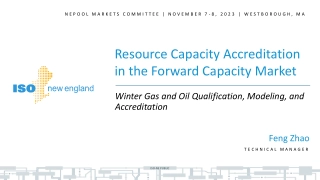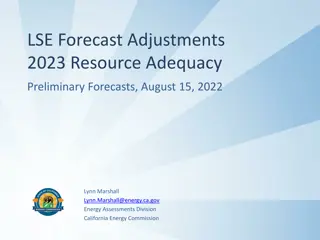Resource Adequacy Forecast Adjustments for 2022
The document provides detailed insights into the process of adjusting load forecasts for resource adequacy in 2022, including steps such as developing reference forecasts, applying adjustments, and evaluating peak demand estimates. It also compares the resource adequacy forecast for 2022 with that of 2021, highlighting changes in total annual capacity and peak demand across different service areas. Additionally, it discusses the reference forecasts for CPUC-jurisdictional LSEs and the annual peak demand forecasts for PG&E and SCE. The information aims to ensure the adequacy of resources in the energy sector for the upcoming year.
Download Presentation

Please find below an Image/Link to download the presentation.
The content on the website is provided AS IS for your information and personal use only. It may not be sold, licensed, or shared on other websites without obtaining consent from the author.If you encounter any issues during the download, it is possible that the publisher has removed the file from their server.
You are allowed to download the files provided on this website for personal or commercial use, subject to the condition that they are used lawfully. All files are the property of their respective owners.
The content on the website is provided AS IS for your information and personal use only. It may not be sold, licensed, or shared on other websites without obtaining consent from the author.
E N D
Presentation Transcript
LSE Forecast Adjustments 2022 Resource Adequacy June 18, 2021 Lynn Marshall Lynn.Marshall@energy.ca.gov Energy Assessments Division California Energy Commission
Resource Adequacy Load Forecast Adjustment Process 1. Develop reference forecast for IOU service areas and direct access 2. Estimate and apply coincidence factors to LSE forecasts. 3. Develop reference current peak demand estimate for LSEs based on available data. 4. Evaluate need for LSE-specific adjustments. 5. Apply adjustments for incremental effects of demand side programs. 6. Apply pro-rata adjustments to bring the total of the forecasts to within 1% of the CEC service area forecast. 7. Evaluate the reasonableness of pro-rata adjustments and total forecast for each LSE and service area. 8. If step 7 indicates pro rata adjustment is too large, review steps 2-7. 2
Comparison of RA 2022 v. RA 2021 Monthly TAC Area Coincident Peak Forecast Jan Feb Mar Apr May Jun Jul Aug Sep Oct Nov Dec PGE TAC TOTAL RA 2020 RA 2021 RA 2022 2022 MW dif pct dif. 14,505 14,171 13,257 14,266 16,429 19,194 20,178 19,459 18,521 15,452 13,786 14,885 14,520 14,115 13,156 14,288 16,593 19,161 19,989 19,203 18,805 15,717 13,630 14,913 14,535 14,122 13,149 14,308 16,810 19,417 20,296 19,493 19,191 15,820 13,697 15,007 15 6 (7) 20 217 255 307 290 386 103 67 94 0.1% 0.0% -0.1% 0.1% 1.3% 1.3% 1.5% 1.5% 2.1% 0.7% 0.5% 0.6% Jan Feb Mar Apr May Jun Jul Aug Sep Oct Nov Dec SCE TAC TOTAL RA 2020 RA 2021 RA 2022 MW dif pct dif. 13,953 13,483 13,687 15,060 16,515 18,624 20,840 21,505 22,604 17,891 14,573 14,410 14,155 13,727 13,868 15,364 16,858 19,000 20,988 21,632 22,263 18,036 14,894 14,706 13,661 13,205 13,374 14,923 16,057 18,693 20,774 21,435 22,177 17,720 14,458 14,245 (493) (522) (494) (442) (801) (307) (214) (198) (87) (315) (437) (461) -3.5% -3.8% -3.6% -2.9% -4.8% -1.6% -1.0% -0.9% -0.4% -1.7% -2.9% -3.1% Jan Feb Mar Apr May Jun Jul Aug Sep Oct Nov Dec SDGE TAC TOTAL RA 2020 RA 2021 RA 2022 2022 MW dif pct dif. 3,110 3,080 2,947 2,961 3,108 3,214 3,412 3,792 3,956 3,517 3,185 3,217 3,084 3,065 2,917 2,946 3,058 3,131 3,360 3,711 3,994 3,443 3,149 3,186 3,043 3,021 2,877 2,890 3,039 3,014 3,203 3,622 3,957 3,418 3,121 3,149 (42) (44) (40) (57) (20) (117) (157) (90) (38) (24) (28) (37) -1.3% -1.4% -1.4% -1.9% -0.6% -3.7% -4.7% -2.4% -0.9% -0.7% -0.9% -1.2% PGE TAC summer peak loads increase SCE and SDGE decrease slightly Source:2020: https://efiling.energy.ca.gov/GetDocument.aspx?tn=236297-1&DocumentContentId=69272; 2021: https://efiling.energy.ca.gov/GetDocument.aspx?tn=231551&DocumentContentId=63367
Service Area Reference Forecast Reference forecast for CPUC-jurisdictional LSE forecasts begins with forecasted monthly TAC coincident peaks from the 2020 Integrated Energy Policy Report Update mid-demand, mid-AAEE case demand forecast. CEC evaluates hourly loads and forecasts for all CAISO LSEs. SDG&E reference forecast equals the TAC area forecast SCE and PG&E TAC forecasts are disaggregated to CPUC and non-CPUC jurisdictional using CEC service area forecast, and LSE forecasts and hourly loads. Service Area Annual (noncoincident) Peak Demand 2018 IEPR, Forecast for 2020 2019 IEPR, Forecast for 2021 2020 IEPR, Forecast for 2022 PG&E SCE 18,165 20,574 18,503 20,881 18,625 20,794 Source: CED 2020 Managed Forecast - LSE and BA Tables Mid Demand - Mid AAEE Case, Form 1.5b https://efiling.energy.ca.gov/GetDocument.aspx?tn=237319&DocumentContentId=70504 4
Disaggregation of PG&E TAC Forecast to CPUC and POU Load 20,000 2,500 18,000 16,000 2,000 14,000 MW (TAC and CPUC) 12,000 1,500 MW (POUs) 10,000 8,000 1,000 6,000 4,000 500 2,000 0 0 Jan Feb Mar Apr May Jun Jul Aug Sep Oct Nov Dec CPUC-Jurisdictional Publicly Owned Utilities 12,987 12,731 11,770 12,772 15,126 17,528 18,278 17,500 17,299 14,186 12,062 13,503 1,549 1,391 1,379 1,536 1,683 1,889 2,018 1,993 1,892 1,634 1,635 1,504 POU loads are about 10% of the TAC. With proportionately more pumping and industrial load, POU loads have a flatter profile across months. 5
Disaggregation of SCE TAC Forecast to CPUC and POU Forecast 25,000 3,000 2,500 20,000 2,000 MW (TAC and CPUC) 15,000 MW (POUs) 1,500 10,000 1,000 5,000 500 0 0 Jan Feb Mar Apr May Jun Jul Aug Sep Oct Nov Dec CPUC-Jurisdictional Publicly Owned Utilities 1,515 12,146 11,846 11,894 13,179 14,230 16,535 18,437 19,014 19,805 15,638 12,706 12,652 1,359 1,481 1,744 1,827 2,158 2,337 2,421 2,372 2,083 1,751 1,593 POU loads are about 11% of the SCE TAC 6
Comparison of CPUC-Jurisdictional RA 2020-2022 Forecasts PGE Service Area RA 2020 RA 2021 RA 2022 2022 MW dif pct dif. SCE Service Area RA 2020 RA 2021 RA 2022 2022 MW dif pct dif. Jan Feb Mar Apr May Jun Jul Aug Sep Oct Nov Dec 13,031 12,647 11,779 12,581 14,738 17,349 18,165 17,510 16,605 13,808 12,179 13,258 13,108 12,690 11,680 12,841 15,015 17,333 18,066 17,318 16,926 13,889 11,826 13,232 12,987 12,731 11,770 12,772 15,126 17,528 18,278 17,500 17,299 14,186 12,062 13,503 (121) 43 (99) 261 277 (15) (99) (192) 320 81 (353) (27) -0.9% 0.3% 0.8% -0.5% 0.7% 1.1% 1.2% 1.1% 2.2% 2.1% 2.0% 2% 12,474 12,149 11,993 13,154 14,600 16,563 18,584 19,193 20,216 15,903 12,913 12,893 12,651 12,279 12,436 13,603 14,954 16,792 18,523 19,114 19,857 15,856 13,080 12,967 12,146 11,846 11,894 13,179 14,230 16,535 18,437 19,014 19,805 15,638 12,706 12,652 (504) (432) (542) (424) (724) (257) (87) (100) (52) (218) (374) (315) -4.0% -3.5% -4.4% -3.1% -4.8% -1.5% -0.5% -0.5% -0.3% -1.4% -2.9% -2.4% Differences parallel changes in the TAC and service area annual peak forecasts 733
Direct Access Reference Estimate Adjustments to ESP forecasts should be consistent with the cap on enrollment, as reflected in recent loads plus expected 2021 and 2022 increases. For each TAC area, historic hourly ESP loads were summed to find the 3-year median of the top 5 coincident peaks, Increase is estimated using sales of load scheduled to switch to direct access service in January 2021 and 2022, historic DA load factors, and DA coincidence factors. Estimated Statewide Direct Access Coincident Peak Demand (MW) 4500 4000 3500 3000 2500 2000 1500 1000 500 0 Jan Feb Mar Apr May Jun Jul Aug Sep Oct Nov Dec Estimated 2020 DA Load 2021 2022 8
Coincidence Adjustments Coincidence adjustments should represent expected LSE demand at the time of a 1-in-2 CAISO-wide system peak. Composite loads of LSEs were constructed by compiling 2020 loads of current and migrating load Median coincident factor during the top 5 peak days is typically used when the month includes a sufficient number of high load days: Load diversity declines as demand rises, so if sample doesn t include enough relatively high load days, diversity will be overestimated, leading to increased unallocated load. Large amounts of demand response, outages, or intra-month load migration can skew statistics For 2020, also evaluated the distribution of coincidence factors for top 10 peak hours. CAISO posts load data used for this analysis annually at: http://www.caiso.com/planning/Pages/ReliabilityRequirements/Default.aspx#Historical 9
Demand Modifier Adjustment LSE forecasts are credited with a share of AAEE and some load modifying demand response (LMDR) to the extent that it is not accounted for in their forecasts LSE share is netted against amounts reported in their forecasts CEC staff reviews other load modifiers (EE, BTM PV, storage, or transportation electrification) in LSE forecasts for consistency with reference forecast. The 2021 IEPR forecast will also include some amount of building electrification If LSEs are planning other types of load-modifying strategies, they should include it in their forecast submitted to the 2021 IEPR. 2022 Incremental Additional Achievable Energy Efficiency TAC PGE SCE SDGE Jan Feb Mar Apr May Jun Jul Aug Sep Oct Nov Dec 171 175 34 166 176 34 174 186 36 163 166 31 200 214 34 255 277 45 301 366 57 287 365 55 265 331 58 207 223 37 179 205 39 167 173 35 10
LSE-Specific Adjustments Staff uses historic loads and temperatures, month-ahead forecasts, and DASR activity to construct a reference estimate for each LSE by service area: Reference estimates were adjusted to allow for economic trends given LSE sector mix A 5% percent deviation is a flag for additional review. LSE forecasts are evaluated using historic loads and temperatures, evaluation of forecast assumptions, and comparison with CEC forecast assumptions IOU departing load estimate are revised for consistency with CCA forecasts as adjusted by CEC, and CEC-estimated direct access load. Aggregate ESP forecasts are evaluated against the direct access reference estimate to identify need for further adjustments IOU forecasts may also be revised for differences with CEC service area forecast 11
Pro-Rata Adjustment If the sum of the adjusted forecasts differs from the service area reference forecast by more than 1%, the exceedance is allocated on the share of an LSE s adjusted forecast of total service area adjusted forecasts. If sum of adjusted ESP forecasts after pro-rata differs from the DA reference estimate by more than 5 percent, individual ESP forecasts are further reviewed. Draft Pro-Rata Adjustment Percent by TAC Jan Feb Mar Apr May Jun Jul Aug Sep Oct Nov Dec PGE SCE SDGE Total 5.1% 3.3% 2.0% 4.0% 7.2% 5.3% 2.5% 5.8% 3.3% 3.9% 2.8% 3.5% 3.2% 4.9% 2.5% 3.9% 2.7% 3.0% 8.3% 3.3% 3.1% 1.8% 4.6% 2.6% 4.0% 1.5% 1.5% 2.6% 0.0% 1.2% 0.0% 0.6% 2.0% 1.9% 1.4% 1.9% 1.4% 2.3% 1.4% 1.9% 3.1% 5.8% 7.1% 4.8% 6.0% 4.2% 5.7% 5.2% 12
Preliminary Estimates of RA 2022 Forecast Adjustments Jan 26,870 Feb 25,777 Mar 25,774 Apr 27,510 May 30,343 Jun 35,203 Jul 38,834 Aug 39,980 Sep 39,559 Oct 31,483 Nov 26,078 Dec 26,748 Submitted LSE Forecasts Coincidence Adjustment (692) (735) (670) (1,130) (1,218) (1,331) (1,408) (1,208) (1,040) (526) (677) (723) LSE Specific Adjustments 887 1,009 534 1,328 2,168 2,203 1,507 1,173 1,747 1,602 1,219 1,791 EE/ LMDR Adjustment Pro rata adjustment to match CEC forecast within 1% (241) (237) (256) (219) (261) (313) (415) (437) (371) (248) (264) (239) 1,070 1,507 893 1,063 1,038 944 1,001 231 754 598 1,256 1,434 Pro-Rata Adjustment % 4.0% 5.8% 3.5% 3.9% 3.3% 2.6% 2.6% 0.6% 1.9% 1.9% 4.8% 5.2% Total Adjusted Forecasts CEC Coincident Peak Reference Forecast Adjusted Forecasts % of Reference 27,894 27,323 26,275 28,553 32,071 36,706 39,519 39,740 40,649 32,910 27,610 29,010 28,176 27,599 26,540 28,841 32,395 37,077 39,918 40,135 41,060 33,242 27,889 29,303 99.0% 99.0% 99.0% 99.0% 99.0% 99.0% 99.0% 99.0% 99.0% 99.0% 99.0% 99.0% Staff is continuing to review and adjust individual forecasts which could reduce pro-rata adjustments. 13
Next Steps Final review of individual forecasts is ongoing For LSE-specific questions contact CEC staff CEC transmits September 2022 load ratio shares to CAISO by June 30 for import and local reliability area capacity allocations Final forecasts due in August should be revised only for load migration 14























